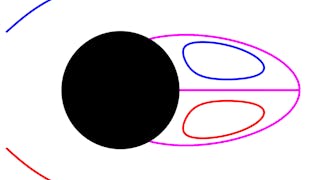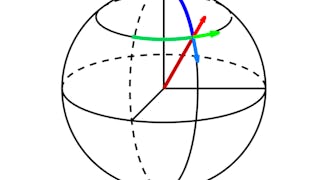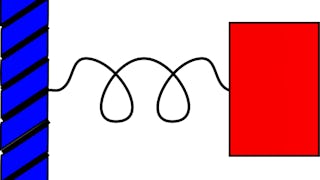Dieser Kurs deckt die wichtigsten numerischen Methoden ab, die ein Ingenieur kennen sollte, einschließlich Wurzelfindung, Matrixalgebra, Integration und Interpolation, gewöhnliche und partielle Differentialgleichungen. Wir lernen, wie man MATLAB zur Lösung numerischer Probleme einsetzt. Alle Studenten, die sich für den Kurs anmelden, erhalten Zugang zu MATLAB online und zum MATLAB Grader. Wir gehen davon aus, dass die Studenten bereits mit den Grundlagen der Matrixalgebra, Differentialgleichungen und Vektorrechnung vertraut sind. Sie sollten über Kenntnisse in einer Programmiersprache verfügen und bereit sein, MATLAB zu erlernen. Der Kurs enthält 74 kurze Vorlesungsvideos und MATLAB-Demonstrationen. Nach jeder Vorlesung oder Demonstration gibt es Aufgaben zu lösen oder Programme zu schreiben. Der Kurs ist in sechs Wochen gegliedert. Am Ende jeder Woche gibt es ein Quiz und ein längeres Programmierprojekt.


Numerische Methoden für Ingenieure
Dieser Kurs ist Teil von Spezialisierung für Mathematik für Ingenieure
Unterrichtet in Deutsch (KI-Synchronisation)

Dozent: Jeffrey R. Chasnov
TOP-LEHRKRAFT
29.368 bereits angemeldet
Bei enthalten
(404 Bewertungen)
Empfohlene Erfahrung
Was Sie lernen werden
MATLAB und die Grundlagen des wissenschaftlichen Rechnens
Wurzelfindungsmethoden wie die Newton-Methode und numerische lineare Algebra unter Verwendung der LU-Zerlegung
Integrationsmethoden wie adaptive Quadratur und Interpolationsalgorithmen unter Verwendung eines kubischen Splines
Numerische Methoden zur Lösung von ODEs, wie z.B. Runge-Kutta, und die Methode der finiten Differenzen zur Lösung von PDEs
Kompetenzen, die Sie erwerben
- Kategorie: Infinitesimalrechnung
- Kategorie: Simulationen
- Kategorie: Schätzung
- Kategorie: Mathematische Software
- Kategorie: Angewandte Mathematik
- Kategorie: Technische Analyse
- Kategorie: Integralrechnung
- Kategorie: Mathematische Modellierung
- Kategorie: Technische Berechnungen
- Kategorie: Grundsätze der Programmierung
- Kategorie: Simulation und Simulationssoftware
- Kategorie: Numerische Analyse
- Kategorie: Plot (Grafiken)
- Kategorie: Lineare Algebra
- Kategorie: Differentialgleichungen
- Kategorie: Algorithmen
- Kategorie: Computergestütztes Denken
- Kategorie: Matlab
- Kategorie: Wissenschaftliche Visualisierung
- Kategorie: Skripting
Wichtige Details

Zu Ihrem LinkedIn-Profil hinzufügen
8 Aufgaben
Erfahren Sie, wie Mitarbeiter führender Unternehmen gefragte Kompetenzen erwerben.

Erweitern Sie Ihre Fachkenntnisse
- Lernen Sie neue Konzepte von Branchenexperten
- Gewinnen Sie ein Grundverständnis bestimmter Themen oder Tools
- Erwerben Sie berufsrelevante Kompetenzen durch praktische Projekte
- Erwerben Sie ein Berufszertifikat zur Vorlage

In diesem Kurs gibt es 6 Module
MATLAB ist eine hochentwickelte Programmiersprache, die von Ingenieuren häufig für numerische Berechnungen und Visualisierungen verwendet wird. Wir lernen die Grundlagen von MATLAB kennen: wie reelle Zahlen mit doppelter Genauigkeit dargestellt werden, wie man mit MATLAB rechnet, wie man Skripte und Funktionen verwendet, wie man Vektoren und Matrizen darstellt, wie man Liniendiagramme zeichnet und wie man logische Variablen, bedingte Anweisungen, for-Schleifen und while-Schleifen verwendet. Für Ihr Programmierprojekt werden Sie einen MATLAB-Code schreiben, um das Bifurkationsdiagramm für die logistische Karte zu berechnen.
Das ist alles enthalten
14 Videos14 Lektüren2 Aufgaben9 App-Elemente
Die Wurzelfindung ist eine numerische Technik zur Bestimmung der Wurzeln oder Nullstellen einer bestimmten Funktion. Wir werden verschiedene Methoden zur Wurzelfindung untersuchen, darunter die Bisektionsmethode, die Newton-Methode und die Secant-Methode. Wir werden auch die Konvergenzordnung für diese Methoden herleiten. Außerdem zeigen wir Ihnen, wie Sie das Newton-Fraktal mit der Newton-Methode in MATLAB berechnen können, und besprechen MATLAB-Funktionen, die zum Finden von Wurzeln verwendet werden können. Für Ihr Programmierprojekt werden Sie einen MATLAB-Code schreiben, der die Newton-Methode verwendet, um das Feigenbaum-Delta aus dem Bifurkationsdiagramm für die logistische Karte zu berechnen.
Das ist alles enthalten
12 Videos8 Lektüren1 Aufgabe3 App-Elemente1 Plug-in
Numerische lineare Algebra ist die Bezeichnung für Matrixalgebra, die auf einem Computer durchgeführt wird. Bei der Durchführung der Gaußschen Eliminierung mit großen Matrizen können Rundungsfehler die Berechnung beeinträchtigen. Diese Fehler können durch die Methode des partiellen Pivotings gemildert werden, bei der vor jedem Eliminierungsschritt die Zeilen ausgetauscht werden. Der LU-Zerlegungsalgorithmus muss dann Permutationsmatrizen einbeziehen. Wir werden auch die Anzahl der Operationen und die Big-Oh-Notation besprechen, um den Anstieg der Rechenzeit bei größeren Problemgrößen vorherzusagen. Wir zeigen, wie Sie die Anzahl der erforderlichen Operationen für die Gaußsche Eliminierung, die Vorwärtssubstitution und die Rückwärtssubstitution zählen können. Wir werden die Potenzmethode zur Berechnung des größten Eigenwerts einer Matrix erklären. Schließlich zeigen wir Ihnen, wie Sie mit der Gaußschen Eliminierung ein System nichtlinearer Differentialgleichungen mit der Newton-Methode lösen können. Für Ihr Programmierprojekt werden Sie einen MATLAB-Code schreiben, der die Newtonsche Methode auf die Lorenz-Gleichungen anwendet.
Das ist alles enthalten
13 Videos10 Lektüren1 Aufgabe4 App-Elemente
Die Berechnung von bestimmten Integralen wird als Quadratur bezeichnet. Wir werden uns mit den Grundlagen der Quadratur befassen, einschließlich elementarer Formeln für die Trapezregel und die Simpson-Regel, der Entwicklung zusammengesetzter Integrationsregeln, einer Einführung in die Gaußsche Quadratur, dem Aufbau einer adaptiven Quadraturroutine, bei der die Software die geeignete Integrationsschrittgröße bestimmt, und der Verwendung der MATLAB-Funktion integral.m. Außerdem werden wir uns mit der Interpolation befassen. Eine gute Interpolationsroutine kann Funktionswerte an dazwischen liegenden Abtastpunkten schätzen. Wir lernen die lineare Interpolation kennen, die üblicherweise für die Darstellung von Daten mit vielen Punkten verwendet wird, sowie die kubische Spline-Interpolation, die zum Einsatz kommt, wenn nur wenige Datenpunkte vorhanden sind. Für Ihr Programmierprojekt werden Sie einen MATLAB-Code schreiben, um die Nullstellen einer Bessel-Funktion zu berechnen. Diese Aufgabe erfordert die Kombination von Quadratur- und Wurzelfindungsroutinen.
Das ist alles enthalten
13 Videos11 Lektüren1 Aufgabe3 App-Elemente
Wir lernen die numerische Integration von gewöhnlichen Differentialgleichungen (ODEs) kennen. Wir stellen die Euler-Methode, eine einstufige Methode erster Ordnung, und die Runge-Kutta-Methoden vor, die die Euler-Methode auf mehrere Schritte und höhere Ordnungen erweitern und damit größere Zeitschritte ermöglichen. Wir werden zeigen, wie man eine Familie von Runge-Kutta-Methoden zweiter Ordnung konstruiert, diskutieren die weit verbreitete Runge-Kutta-Methode vierter Ordnung und wenden diese Methoden zur Lösung von ODE-Systemen an. Wir zeigen Ihnen, wie Sie die MATLAB-Funktion ode45.m verwenden und wie Sie eine Zweipunkt-Randwert-ODE mit der Schießmethode lösen. Für Ihr Programmierprojekt werden Sie eine numerische Simulation des gravitativen Zweikörperproblems durchführen.
Das ist alles enthalten
13 Videos9 Lektüren1 Aufgabe3 App-Elemente
Wir werden lernen, wie man partielle Differentialgleichungen (PDEs) löst. Obwohl es sich hierbei um ein umfangreiches Thema mit verschiedenen spezialisierten Lösungsmethoden handelt, wie z.B. in der numerischen Strömungsmechanik, werden wir eine grundlegende Einführung in dieses Thema geben. Wir werden die PDE-Lösungen in Randwertprobleme und Anfangswertprobleme unterteilen. Anschließend werden wir die Finite-Differenzen-Methode zur Lösung von PDEs anwenden. Wir werden die Laplace-Gleichung, ein Randwertproblem, mit zwei Methoden lösen: einer direkten Methode über Gaußsche Eliminierung und einer iterativen Methode, bei der die Lösung asymptotisch angenähert wird. Als nächstes werden wir die eindimensionale Diffusionsgleichung, ein Anfangswertproblem, mit der Crank-Nicolson-Methode lösen. Wir werden auch die Von-Neumann-Stabilitätsanalyse anwenden, um die Stabilität von Zeitintegrationsverfahren zu bestimmen. Für Ihr Programmierprojekt werden Sie die zweidimensionale Diffusionsgleichung mit der Crank-Nicolson-Methode lösen.
Das ist alles enthalten
17 Videos15 Lektüren2 Aufgaben4 App-Elemente
Erwerben Sie ein Karrierezertifikat.
Fügen Sie dieses Zeugnis Ihrem LinkedIn-Profil, Lebenslauf oder CV hinzu. Teilen Sie sie in Social Media und in Ihrer Leistungsbeurteilung.
Dozent

TOP-LEHRKRAFT
Mehr von Mathematik und Logik entdecken
 Status: Vorschau
Status: VorschauLudwig-Maximilians-Universität München (LMU)
 Status: Kostenloser Testzeitraum
Status: Kostenloser TestzeitraumThe Hong Kong University of Science and Technology
 Status: Kostenloser Testzeitraum
Status: Kostenloser TestzeitraumThe Hong Kong University of Science and Technology
 Status: Kostenloser Testzeitraum
Status: Kostenloser TestzeitraumThe Hong Kong University of Science and Technology
Warum entscheiden sich Menschen für Coursera für ihre Karriere?




Bewertungen von Lernenden
404 Bewertungen
- 5 stars
90,61 %
- 4 stars
7,16 %
- 3 stars
0,98 %
- 2 stars
0,49 %
- 1 star
0,74 %
Zeigt 3 von 404 an
Geprüft am 2. Jan. 2023
very Fantastic core course for all engineering and science students to take. Many thanks again to Prof. Jeffrey Chasnov and everyone for making this happen. God bless you.  
Geprüft am 22. Aug. 2021
It's really a privilege for me to be a part of this course. I was able to learn a lot. Thanks Professor for this amazing course.
Geprüft am 18. Mai 2023
I have been impressed by this course. Now I am well-equipped for tackling all complex problems. Thank you is not enough!

Neue Karrieremöglichkeiten mit Coursera Plus
Unbegrenzter Zugang zu 10,000+ Weltklasse-Kursen, praktischen Projekten und berufsqualifizierenden Zertifikatsprogrammen - alles in Ihrem Abonnement enthalten
Bringen Sie Ihre Karriere mit einem Online-Abschluss voran.
Erwerben Sie einen Abschluss von erstklassigen Universitäten – 100 % online
Schließen Sie sich mehr als 3.400 Unternehmen in aller Welt an, die sich für Coursera for Business entschieden haben.
Schulen Sie Ihre Mitarbeiter*innen, um sich in der digitalen Wirtschaft zu behaupten.
Häufig gestellte Fragen
Um Zugang zu den Kursmaterialien und Aufgaben zu erhalten und um ein Zertifikat zu erwerben, müssen Sie die Zertifikatserfahrung erwerben, wenn Sie sich für einen Kurs anmelden. Sie können stattdessen eine kostenlose Testversion ausprobieren oder finanzielle Unterstützung beantragen. Der Kurs kann stattdessen die Option "Vollständiger Kurs, kein Zertifikat" anbieten. Mit dieser Option können Sie alle Kursmaterialien einsehen, die erforderlichen Bewertungen abgeben und eine Abschlussnote erhalten. Dies bedeutet auch, dass Sie kein Zertifikat erwerben können.
Wenn Sie sich für den Kurs einschreiben, erhalten Sie Zugang zu allen Kursen der Spezialisierung, und Sie erhalten ein Zertifikat, wenn Sie die Arbeit abgeschlossen haben. Ihr elektronisches Zertifikat wird Ihrer Seite "Leistungen" hinzugefügt - von dort aus können Sie Ihr Zertifikat ausdrucken oder Ihrem LinkedIn-Profil hinzufügen.
Ja. Für ausgewählte Lernprogramme können Sie eine finanzielle Unterstützung oder ein Stipendium beantragen, wenn Sie die Anmeldungsgebühr nicht aufbringen können. Wenn für das von Ihnen gewählte Lernprogramm eine finanzielle Unterstützung oder ein Stipendium verfügbar ist, finden Sie auf der Beschreibungsseite einen Link zur Beantragung.
Weitere Fragen
Finanzielle Unterstützung verfügbar,

